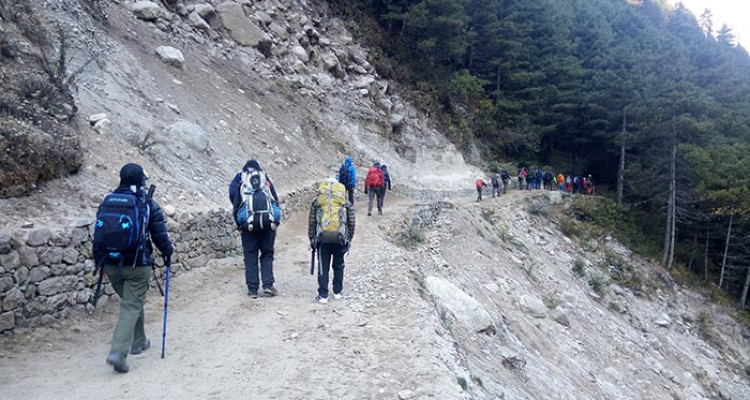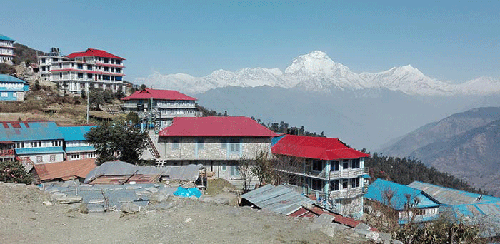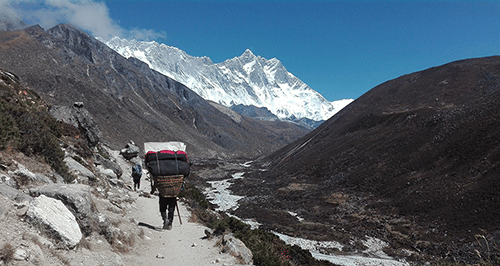April 24, 2018

Nepal is a Himalayan kingdom that offers a range of adventure activities including trekking, tours, rafting, paragliding, bungee, and more. There are several easy and short treks suitable for less experienced travelers such as families, kids, students, and those who are not physically fit. We recommend three easy treks that you can choose from based on your budget and time.
While Nepal is famous for adventurous treks like the Everest Base Camp, Gokyo Valley Trek, and Annapurna Circuit Trek, these trips usually take over two weeks to complete and are recommended for seasoned adventure travelers.
However, there are numerous options available for travelers who are not as experienced. Short and easy treks offer ample opportunities to explore Himalayan vistas, local cultures, and lifestyles. The most popular, short, easy, and affordable trekking routes include:
1. Poon hill trekking
2. Langtang valley trekking
3. Short Everest trekking

Poon Hill Trekking is one of the most popular and breathtaking treks in the Annapurna region of Nepal. The trek is named after Poon Hill, a famous viewpoint that offers stunning panoramic views of the Himalayas including the Annapurna and Dhaulagiri mountain ranges.
The trek starts from the beautiful city of Pokhara and passes through lush forests, rhododendron flowers, and traditional villages. The trail is well-marked and passes through various villages inhabited by Gurung and Magar communities. These villages offer a glimpse into the unique culture and lifestyle of the local people.
The trek is relatively easy and suitable for novice trekkers, families, and senior citizens. The highest point on the trek is Poon Hill at an altitude of 3210 meters, which can be reached after a short hike from the Ghorepani village.
The sunrise view from Poon Hill is a highlight of the trek, with the majestic Himalayas illuminated in golden light. The view of the snow-capped peaks of Annapurna, Dhaulagiri, and Machhapuchhre (Fishtail) is truly breathtaking.
The trek can be completed in 4-5 days and can be extended or shortened based on the traveler’s preference. The best time to undertake this trek is from March to May and from September to November when the weather is favorable with clear skies and mild temperatures.
Overall, Poon Hill Trekking is a perfect way to experience the natural beauty and cultural diversity of Nepal’s Himalayas in a short and easy trek. It’s a highly recommended trek for those looking for a memorable adventure without pushing themselves to their physical limits.
The best time to go on the Poon Hill trek in Nepal is during the autumn season, which is from September to November, and during the spring season, which is from March to May.
During the autumn season, the weather is generally clear and dry, providing excellent views of the Himalayan mountains. The temperature is also moderate, making it comfortable for trekking. In addition, the autumn season is also the time for several festivals, such as Dashain and Tihar, which add to the cultural experience of the trek.
During the spring season, the weather is mild and dry, making it another great time to trek in the area. The temperature is also pleasant, and the blooming rhododendron flowers add to the beautiful scenery. Additionally, the spring season is also a good time for bird watching as many migratory birds come to the area.
However, it is important to note that the Poon Hill trek can be done year-round, but during the winter months (December to February) it can be quite cold and during the monsoon season (June to August) the trail can be slippery and muddy due to rain.
The top 10 highlights of the Poon Hill Trek include:
Poon hill trek Itinerary:
Day 1: Drive from Pokhara to Nayapul and trek to Tikhedhunga
Day 2: Trek from Tikhedhunga to Ghorepani
Day 3: Hike to Poon Hill and trek to Tadapani
Day 4: Trek from Tadapani to Ghandruk and drive back to Pokhara
Note: This itinerary is just a suggestion and can be adjusted based on your preferences and physical abilities. It’s always a good idea to consult with a licensed trekking agency or guide before embarking on a trek in Nepal.

Langtang Valley Trekking is a popular and rewarding trek in the Langtang region of Nepal, which lies to the north of the Kathmandu Valley. The trek is known for its scenic beauty, diverse landscapes, and cultural attractions.
The trek starts from the town of Syabrubesi and follows the Langtang River, passing through dense forests of oak, rhododendron, and bamboo. The trail offers breathtaking views of snow-capped peaks, including Langtang Lirung (7,227 m), Gang Chhenpo (6,387 m), and Dorje Lakpa (6,990 m).
The Langtang Valley is inhabited by the Tamang people, who have a unique culture and tradition that is distinct from other ethnic groups in Nepal. The trek passes through several Tamang villages, where visitors can experience the local lifestyle, cuisine, and hospitality.
The highlight of the trek is Kyanjin Gompa, a Buddhist monastery and cheese factory located at an altitude of 3,870 meters. The monastery offers a panoramic view of the surrounding mountains and is a great place to explore the local culture and religion.
The trek can be completed in 7-10 days, and the best time to undertake the trek is from March to May and from September to December when the weather is pleasant and the skies are clear.
Overall, Langtang Valley Trekking is an excellent choice for those seeking an immersive cultural experience and stunning mountain vistas. It’s a moderate trek suitable for all fitness levels, and the route is less crowded than other popular treks in Nepal, making it an ideal destination for those looking for a quieter and more peaceful adventure.
The best time to go on the Langtang Valley Trek in Nepal is during the autumn season (September to November) and the spring season (March to May).
During the autumn season, the weather is usually stable, dry, and clear, providing excellent visibility and great views of the surrounding mountains. The temperatures are also pleasant, making it comfortable for trekking. Autumn is also the time when many festivals are celebrated in Nepal, including the biggest Hindu festival, Dashain, and the Tihar festival, which can add to the cultural experience of the trek.
The spring season is another great time to trek in the Langtang Valley. The weather is usually mild and dry, with blooming rhododendron flowers adding to the beautiful scenery. The temperatures are pleasant and it is a good time for bird watching as many migratory birds come to the area.
It is worth noting that the weather in the mountains can be unpredictable, so it is important to be prepared for cold temperatures, strong winds, and occasional snowfall even during the best times to trek. It is always advisable to check weather forecasts and consult with experienced trekking guides before embarking on the trek. Additionally, the Langtang Valley Trek can be done during the winter months (December to February), but it can be quite cold and snowy, and during the monsoon season (June to August), the trail can be slippery and muddy due to rain.
Langtang valley trek Highlights
The Langtang Valley Trek in Nepal offers a unique and stunning trekking experience, with several highlights including:
Overall, the Langtang Valley Trek offers a perfect blend of natural beauty, cultural experience, and adventure, making it one of the most popular treks in Nepal.
Langtang valley trek Itinerary
Here is a sample itinerary for the Langtang Valley Trek in Nepal:
Day 1: Drive from Kathmandu to Syabrubesi
Day 2: Trek from Syabrubesi to Lama Hotel
Day 3: Trek from Lama Hotel to Langtang Village
Day 4: Trek from Langtang Village to Kyanjin Gompa
Day 5: Hike to Tserko Ri and back to Kyanjin Gompa
Day 6: Trek back to Lama Hotel
Day 7: Trek back to Syabrubesi
Day 8: Drive back to Kathmandu
Note: This itinerary is just a suggestion and can be adjusted based on your preferences and physical abilities. It’s always a good idea to consult with a licensed trekking agency or guide before embarking on a trek in Nepal.
Short Everest Trek

The Short Everest Trek is a popular and convenient trekking option in the Everest region of Nepal. It is considered one of the three easy treks in Nepal, making it an ideal choice for trekkers who are short on time or who prefer an easier trekking experience.
Starting from the beautiful Sherpa village of Lukla, the trek takes you through the picturesque Phakding village, which is surrounded by rolling green hills and pine forests. As you trek, you will be greeted with spectacular views of the Everest region, including the world’s tallest mountain, Mount Everest.
Despite being in the Everest region, the Short Everest Trek is a relatively easy and short trek with a low altitude. The trek can be completed in a few days, making it accessible to inexperienced trekkers or those who are traveling with their families.
The highest point of the trek is Syangbuche hill, which is located at an altitude of 3780 meters. From here, trekkers can enjoy panoramic views of Mount Everest, Ama Dablam, Thamserku, and other popular mountains in the region.
During the trek, you will also have the opportunity to visit the Sherpa Museum, which offers a unique and interesting insight into the Sherpa culture and way of life.
Although there are many trekking regions and paths in Nepal, the Short Everest Trek, along with the Poon Hill Trek and the Langtang Valley Trek, are considered the three easy treks in Nepal. These treks are safe, offer easy access to food and accommodation, and provide trekkers with the opportunity to experience the Himalayan vistas, local life, culture, and flora and fauna of Nepal.
You can embark on a short and effortless trek in Nepal, either in the Everest region, Langtang region, or Annapurna region. For instance, a budget-friendly and brief trekking option in Nepal is the Annapurna & Langtang trek.
The best time to go on the Everest View Trek in Nepal is during the autumn season (September to November) and the spring season (March to May).
During the autumn season, the weather is usually stable, dry and clear, providing excellent visibility and great views of the surrounding mountains. The temperatures are also pleasant, making it comfortable for trekking. Autumn is also the time when many festivals are celebrated in Nepal, including the biggest Hindu festival, Dashain, and the Tihar festival, which can add to the cultural experience of the trek.
The spring season is another great time to trek in the Everest region. The weather is usually mild and dry, with blooming rhododendron flowers adding to the beautiful scenery. The temperatures are pleasant and it is a good time for bird watching as many migratory birds come to the area.
It is worth noting that the weather in the mountains can be unpredictable, so it is important to be prepared for cold temperatures, strong winds, and occasional snowfall even during the best times to trek. It is always advisable to check weather forecasts and consult with experienced trekking guides before embarking on the trek.
Major highlights of a short Everest Trek:
Short Everest Trek itinerary
Here’s a sample itinerary for a short Everest Trek:
Day 1: Fly to Lukla and Trek to Phakding (2,610m/8,562ft)
Day 2: Trek to Namche Bazaar (3,440m/11,286ft)
Day 3: Acclimatization Day in Namche Bazaar
Day 4: Trek to Tengboche (3,860m/12,660ft)
Day 5: Trek back to Namche Bazaar
Day 6: Trek back to Lukla
Day 7: Fly back to Kathmandu
Note: This itinerary is just a suggestion and can be adjusted based on your preferences and physical abilities. It’s always a good idea to consult with a licensed trekking agency or guide before embarking on a trek in Nepal.